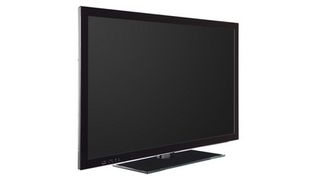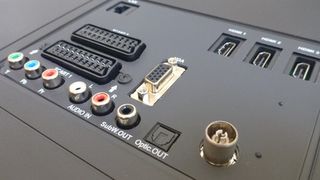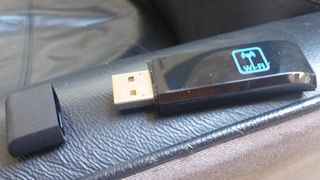TechRadar Verdict
After a barnstorming start with its awesome design, multiple HDMI inputs and apps aplenty, the Finlux 40S8070-T limps over the line after a picture performance that squeaks a pass mark.
Pros
- +
BBC iPlayer
- +
Single pane of glass design
- +
100Hz processing
- +
Low price
Cons
- -
Poor sound
- -
Limited smart TV apps
- -
Lacks shadow detail
- -
LED light leakage
Why you can trust TechRadar
Finlux isn't a brand we've been too familiar with of late, but its recent revival as a web-only business has seen a rush of thoroughly affordable LED-backlit and even 3D TVs hit the virtual shelves.
The key 40-inch size in its range is represented by the Finlux 40S8070-T, which comes to use with a luscious design alongside all the must-haves of the modern TV age. A Freeview HD tuner, Full HD resolution, USB playback, networking, smart TV apps - including BBC iPlayer, YouTube and social media - alongside four HDMI inputs and USB recording are all present.
The Finlux 40S8070-T - which, oddly, bears no Finlux logo on its front - is also a great-looking TV. It claims a frameless design that's really nothing of the sort, though the use of a single pane of glass across the front is on-trend.

It reminds us of LG and Sony TVs, and though it's attractive there is the issue of screen reflections. The Finlux 40S8070-T is best watched in a blackout and certainly shouldn't be positioned opposite a light source.
Although 'frameless', there is a gap of 33mm/1.3 inches between the edge of the TV and the screen, with a further 2mm/0.08 inches of black around the image. There's also a 2mm-thin transparent edge around the Finlux 40S8070-T, which catches the light nicely and lets off the odd sparkle.
In terms of screen depth, the Finlux 40S8070-T measures around 40mm/1.57 inches deep, which is reasonably normal at this price.

The Finlux 40S8070-T has a full price of £649.99 (around US$990 / AU$950), though it's currently being sold for £419.99 (around US$640 / AU$614).
Owned by Turkey-based TV makers Vestel - the third largest television manufacturer in the world, with 25% of the UK market - the Finlux brand now covers a fast-growing range of LED-backlit LCD TVs that are closely mirroring the major developments in the bigger TV brands' lineups.
That said, there is only one close rival to the Finlux 40S8070-T from within the Finlux camp; the 40-inch Finlux 40F8030-T (£499.99), which ditches both the 'frameless' design and the 100Hz processing, the latter of which might be a problem at this size.

Further up the Finlux food chain are its flagship TVs, the 47-inch Finlux 47S9100-T (£899.99) and 55-inch Finlux 55S9100-T (£1,299.99), which both add passive 3D and a slimmer 36mm/1.42-inch depth.
However, the real boat-rocker is the monster 65-inch Finlux 65F8200-T, which currently sells for just £1299.99, reduced from a full price of £1,799.99. The age of affordable giant-sized TVs is upon us.
Features
Aside from its Freeview HD tuner, the Finlux 40S8070-T is all about apps. The smart TV portal on the TV is a slightly antiquated version compared to newer TVs in the Finlux range, but there are actually more apps available here.
As well as BBC iPlayer, Facebook, Twitter and YouTube, the Finlux 40S8070-T adds Viewster, CineTrailer, ITN, Foreca, TuneIn Radio, MeteoNews.TV, Solitaire Club, Autozine, eBay, iConcerts, Joomeo and Qualifiers 2014, most of which won't get used much but could be mildly diverting. It's a shame that the likes of Now TV, Netflix and Lovefilm don't appear.

As well as this grid of apps, the Finlux 40S8070-T has four sponsored areas at the bottom of the screen sporting links to CineTrailer, Twitter, Facebook and Picasa, the latter of which doesn't appear to be available as a dedicated app elsewhere.
Unlike its largely second-rate apps, the Finlux 40S8070-T's ins and outs are exhaustive. The headline act on the back has to be three HDMI inputs, though there's a fourth available on the side panel, too. Underneath those HDMI slots on the rear are two Scarts, a VGA input for a PC, and a set of component video inputs.
Audio is dealt with by an optical digital audio link, a subwoofer output and some stereo audio outputs. Elsewhere on the side panel is a composite video input, which is useful for legacy games consoles and camcorders - two USB slots, a headphones slot and a Common Interface slot for adding channels to the Finlux 40S8070-T's built-in Freeview HD tuner.

Picture processing circuitry is limited, as are tweaks and adjustments, with only the likes of skin tone, colour shift and RGB Gain controls to experiment with, precluding any kind of extensive calibration.
However, in addition to a 100Hz mode, the Finlux 40S8070-T does possess an HDMI TruBlack mode and a notable frame interpolation option. The latter, called Movie Sense, is available in several strengths and - if it's effective - could introduce a dizzying realism to Blu-ray discs that removes judder and creates a flowing, video-like look, much like upping the frame rate in the recent movie The Hobbit. It's not to everyone's taste.
Finlux also provides a mini CD copy of Nero MediaHome 4 Essentials for streaming via DLNA from a Windows computer, though that was no good for our Windows netbook or our Mac. Who uses discs? Surely it should be a free download. It's especially ironic, because the Finlux 40S8070-T is only available to buy online.

Jamie is a freelance tech, travel and space journalist based in the UK. He’s been writing regularly for Techradar since it was launched in 2008 and also writes regularly for Forbes, The Telegraph, the South China Morning Post, Sky & Telescope and the Sky At Night magazine as well as other Future titles T3, Digital Camera World, All About Space and Space.com. He also edits two of his own websites, TravGear.com and WhenIsTheNextEclipse.com that reflect his obsession with travel gear and solar eclipse travel. He is the author of A Stargazing Program For Beginners (Springer, 2015),


